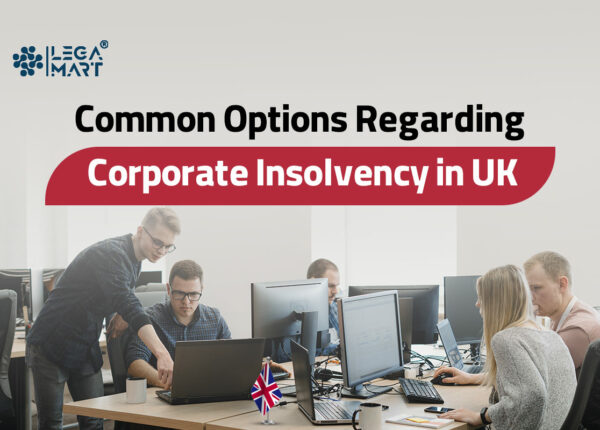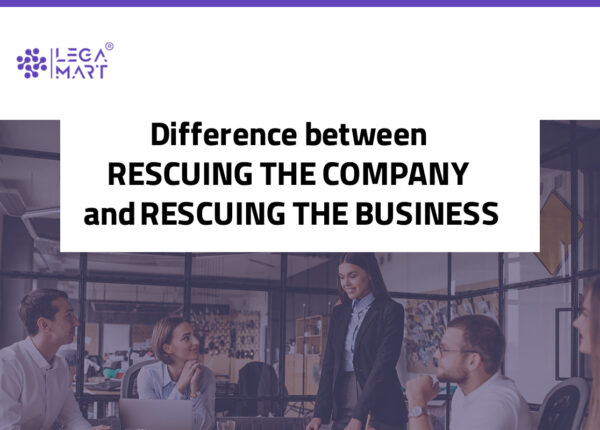Introduction
Navigating the intricate landscape of corporate insolvency in UK is a critical undertaking for businesses and stakeholders. The UK provides a great atmosphere for young entrepreneurs to start their small business and even expand their small business. However, as economic landscapes evolve and market dynamics shift, understanding the nuances of corporate insolvency becomes paramount for ensuring the survival, revival, or responsible dissolution of companies.
This Legamart article will try to shed light on the complex world of corporate bankruptcy in the United Kingdom, providing a succinct but informative explaination of the procedures, legislation, and ramifications that influence the fate of failing organizations. It will also serve as your compass across the hard terrain, offering a short and instructive review of the essential elements that characterize corporate bankruptcy in the UK, whether you are a company owner, creditor, investor, or just wanting to understand the complexity of insolvency.
Corporate and Securities Law in Turkey – Legamart
Insolvency legislation in the UK
When a corporation declares insolvency in the UK, it must comply with all of the laws that govern the insolvency process in the United Kingdom. The Insolvency Act 1986 and the Insolvency Rules 2016 are the primary pieces of UK corporate insolvency legislation. In addition, there are further rules complementing these acts for regulating the process of insolvency in the UK, such as The (Company Voluntary Arrangement and Administration) Rules 2018 and the Insolvency (Receivership and Winding up) Rules 2018.
Top 4 Remarkable Tax Tips UK and Poland
When a corporate is declared insolvent?
In the UK, a company becomes insolvent when it fails to meet its financial obligations and commitments. Insolvency can trigger various legal procedures like administration, liquidation, or voluntary arrangements to manage the company’s financial difficulties and distribute its assets among creditors.
To navigate these complex matters, companies facing financial distress must seek guidance from qualified professionals, as the regulations surrounding insolvency may change over time.
As the companies go insolvent, the directors have liability for fulfilling specific responsibilities like ceasing trade and overdrawing a large sum, which could result in sanctions and allegations.
The Insolvency Act of 1986 (the act) does not specify when a company becomes insolvent. However, everything depends on when a corporation can ” pay its debts.” Section 123 of the Act establishes two primary criteria for assessing whether a corporation cannot pay its debts.
First criteria – The “cash flow test” is stated in Section 123(1) of the act, which states that a company is deemed insolvent if (among other things):
It is proven to the court’s satisfaction that the corporation is unable to fulfil its commitments as they come due; or
A creditor who filed a written demand over £750 has not been met, or the amount has not been resolved to the creditor’s reasonable satisfaction within three weeks of the creditor’s demand; or
A court has ordered execution, payment, or procedure in favor of a creditor, and the order has been returned unsatisfied (in whole or part).
Here, it means that a Cash flow test applies when a UK company cannot pay their obligations on time. Also, a firm is considered insolvent if it cannot satisfy its financial commitments now or in the future. This test determines the company’s financial stability and future financial trouble (if any).
The second criterion is the “balance sheet test “. Section 123(2) of the Act states that a firm is judged unable to pay its obligations if it can demonstrate to the court that its assets are worth less than the number of its liabilities, including contingent and prospective liabilities.
If sufficient evidence shows that a corporation fails either of these requirements, it is termed insolvent because it lacks adequate assets to satisfy its debts or cannot pay its payments on time. In reality, the tests are frequently challenging to determine, especially in borderline circumstances where contingent or unquantifiable hazards occur or when deciding how far into the future to examine or foresee when applying the tests.
Common options regarding corporate insolvency in UK

There are various choices available if a corporation has been declared to fall into corporate insolvency in the UK. You can visit the LegaMart directory and employ a lawyer to grasp all the options that suit your case based on your questions from your smartphone.
Yet, to give you brief information, below are the standard options to consider:
Liquidation
In the case of corporate insolvency in the UK, there may be no suitable alternative course of action if a corporation cannot pay all of its debts other than putting the business into liquidation. Liquidation is a terminal procedure; unlike other forms of insolvency, the corporation will not be resurrected and eventually dissolved. The liquidation process entails the appointment of an insolvency practitioner (the liquidator) to gather and realise a company’s assets before distributing the realisations per a stipulated statutory order to (partially) fulfil the company’s liabilities.
There are two types of liquidation –
Compulsory liquidationCompulsory liquidation is the procedure that happens when a judge orders that a corporation be wound up.
This happens when a creditor petitions the insolvency court with an unpaid debt of £750 or more because the business cannot pay its obligations or is balance sheet insolvent, and the court orders the firm to be wound up.
Voluntary liquidationVoluntary liquidation is when a business’s board or shareholders agree that the firm should be wound up. It is not required for the firm to be bankrupt before filing for voluntary liquidation.
Voluntary liquidation is classified into two types:
- Members’ voluntary liquidation (MVL)
- Creditors’ voluntary liquidation (CVL)
A members’ voluntary liquidation happens when the firm can pay its obligations within 12 months (solvent), and the directors swear a statutory statement of solvency proclaiming it.
When the directors fail to swear a statutory statement of solvency, the creditors’ voluntary liquidation occurs. In this circumstance, a creditors’ meeting is normally conducted on the same day as the shareholders’ meeting that legally decides to dissolve the firm.
Pre-packaged administration
Pre-packaged administration is a kind of administration in which the sale of the company is negotiated before the administration, which is then entered into for the administrator to effect the transaction. Pre-packaged administration is an effective strategy to preserve value for a company and its creditors.
The purpose of this administration is to provide a seamless transition for a company’s existence. It is also used to protect a company’s worth, secure increased realisations for creditors (by sale proceeds), and save employment (albeit this is not a formal administration goal). An insolvency practitioner will help a firm before it is sold if it has gone into pre-packaged administration.
Administration
The administration regime, which is a hybrid approach when facing a case of corporate insolvency in the UK, is outlined in Schedule B1 to the act. A statutory purpose for an administration must be one of three:
- To save the business as a going concern, or if this is not possible;
- To produce a greater overall return for creditors than would be probable if the company were wound up without first going through administration or if this is not practicable;
- To sell the property to pay off one or more secured or favoured creditors.
During the initial administration stage, creditors are barred from acting against the company. Administrators might seek to reorganise the business or devise a more effective way to sell the company’s assets. Administrators are required by law to market and sell the company or any components worth salvaging as a continuing concern. Without this, the administrator must choose the best way to realise the assets so they are worth more to creditors than if the company was liquidated.
Administrative receivership
When a business borrows money, the company or organisation lending the money frequently requests some form of collateral against the business’s assets as a secured creditor (fixed or floating charge holder).
The administration is distinct from administrative receivership. Under section 29 of the Act, a holder of a floating charge over all or nearly all of a company’s assets may be allowed to name an administrative receiver over the business. The appointment holder in administration is responsible for all unsecured creditors, whereas the administrative receiver only has a duty to that particular lender.
Unsecured creditors cannot initiate administrative receiverships. However, they can start the administration procedure (as described in section 3).
The enterprise act 2002 eliminated administrative receivership, making it the least common insolvency option today. The ability of a floating charge holder to name an administrative receiver was significantly constrained by a change in legislation in 2002. It is still permissible to designate an administrative receiver with a charging instrument signed before September 15, 2003, or with a few specific, limited exclusions, like a capital markets exemption. However, administrative receivership is extremely rare, and the holder of a floating charge will often need to appoint an administrator rather than an administrative receiver.
Company voluntary agreements(CVA)
A company voluntary arrangement (CVA) is a method that allows an over-indebted company, or in other words, a company in the case of corporate insolvency in the UK, to reach an agreement with its creditors on how to handle its obligations. Companies that fit within corporate insolvency in the UK can use this method with other insolvency procedures, such as administration. Combining a CVA with an administration can benefit from the automatic moratorium that applies to administrations.
A voluntary arrangement is defined in Section 1 of the Act as either a composition in payment of its obligations or a scheme for organising the company’s affairs. In essence, a CVA provides a company that falls into corporate insolvency in the UK with a “second opportunity” to restructure its operations voluntarily (but with specific options) without filing for terminal bankruptcy. A CVA can also be used as a distribution method when it is preferable to avoid liquidation procedures. A corporation does not have to be formally bankrupt to undertake a CVA.
CVAs involve arrangements between administrators and creditors based on proposals made by the directors, the liquidator, or the administrator if the firm is in liquidation or administration. The CVA becomes effective after the members and creditors have accepted it. On the other hand, the CVA can be challenged in court within 28 days after it files for unfairness or severe irregularity in the voting processes and reports of the members’ and creditors’ votes. As a result, the CVA generally becomes effective at the end of the 28-day challenge.
Difference between rescuing the company and rescuing the business

Generally, rescuing a corporation entails rescuing the whole corporate entity from bankruptcy and liquidation. This strategy focuses on resolving the underlying financial concerns and restoring the company’s long-term sustainability. The major goal is to keep the firm running, keep employees, and repay creditors as much as feasible.
In contrast, business rescue entails distinguishing the viable components of a financially challenged organization from the non-viable components and maintaining those viable components. This strategy might include selling off certain assets, divisions, or business units to other corporations or investors. The main objective is to keep the critical components of the business running even if the original firm cannot be preserved entirely.
Therefore, while rescuing a corporate entity via the bankruptcy process is often accomplished through a CVA, rescuing a business is typically accomplished through an administration with a certified insolvency practitioner acting as an administrator who negotiates the sale of the firm and its assets to a corporation.
An administration is often performed prior to a CVA. This is since an order of administration will provide the firm with a moratorium while it is saved via a CVA. A moratorium in the CVA process is also possible for many small businesses due to a 2000 revision to the insolvency rules.
Further, in CVA, the directors maintain control of the management and have certain liabilities towards the company, but in administration, the administrator replaces the management and acts as an agent for the business.
Conclusion
In conclusion, understanding UK corporate insolvency’s complex procedures and laws is essential. The UK’s insolvency system is strong and flexible for enterprises in financial trouble. As the corporate environment evolves, keeping up with regulatory changes and industry developments is crucial for controlling bankruptcy risks. Companies may minimise financial difficulties and strive toward a more secure and successful future by following best practices and being transparent and ethical.




